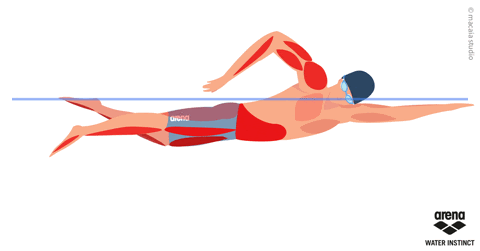Having the right technique is half the battle in the triathlon swim, so which one is best for triathlon and what are the key elements?
Although there are several to choose from, Freestyle tends to be the triathlon swimming stroke of choice.
If you watch triathlons regularly or happen to see a triathlon team training, you’ll notice that the fastest and most effective swimmers seem almost lazy in their stroke. Their heads are very low, the kick is rapid and shallow, their arms puncture the water rather than a splash and their arms are bent and stay close to their bodies.
They are also invariably doing freestyle rather than other Triathlon swimming strokes, which is faster and more efficient.
The reason for this is that efficiency is king and any energy that’s not adding to overall performance has to be conserved, making the freestyle the best triathlon swimming stroke. The high elbow stroke is more efficient as it transfers the most power backwards rather than downwards. The kick adds little propulsive power but keeps the body streamlined, and the low head minimises drag that can act as a brake as you breathe.
You aren’t restricted to freestyle and all are permitted in most races, but there are pros and cons to all.
Freestyle

Freestyle is the most commonly used triathlon swimming stroke but, if you have a difficulty with this or a preference for another stroke that’s fine and all strokes are allowed in races with the possible exception of backstroke depending on the organisers
In freestyle or crawl, the body is face down, with the head maintained in the water as much as possible. The arms come over the shoulders out of the water and reach forward before being pushed back under the body to provide propulsion. Once the arms reach down to the hips they are recovered out of the water to complete the stroke. The legs tend to kick from the hips with pointed toes like flippers,
Breathing is accomplished by tilting the head to one side to inhale and spent air is exhaled into the water.
Freestyle has a number of advantages. Firstly, it adopts the most streamlined position in the water with the head pointing down and forward. It’s also the fastest technique by a considerable margin.
Breaststroke.
The second most common stroke is breaststroke, which has a couple of advantages especially for open water and is a common recovery stroke for triathletes. Like freestyle, you are looking forward during the stroke, which naturally pushes your head out of the water which aids breathing and sighting, which keeps you swimming in the right direction. This also helps psychologically because you have visibility around you which can reduce any panic caused by having your head underwater.
The stroke is more balanced than freestyle and uses more of the leg muscles, which, although not ideal in terms of the subsequent events, can definitely help if your shoulders are tiring during the swim.
It is, however, the most energy-intensive stroke and definitely the slowest.
Backstroke
Backstroke isn’t quite freestyle in reverse as it uses the legs more for propulsion than the arms, simply because it is more difficult to engage the arms efficiently when pulling behind you. It’s definitely faster than breaststroke, but there’s not a lot in it! It’s also much easier to breathe what breaststroke because your face is out of the water but still in a streamlined position.
The biggest issue with breaststroke, however, is visibility. You have no real sense of what’s in front of you, so sighting can be a real issue and there is a good chance of crashing into other competitors, bollards or support boats! For this reason, some races will not allow competitors to do the backstroke, and it is generally reserved for recovery or if a swimmer is in distress.
Butterfly
You’ll often see swimmers utilising the Butterfly kick at the start of beach swims to get through shallow water, but apart from that isn’t common. In theory, though it has a lot going for it as it utilises core muscle strength in for propulsion as well as legs and Arms, making it potentially more powerful and more balanced.
However, few people are taught to butterfly properly and bad technique significantly reduces the potential power benefits of the stroke. It’s also wider than freestyle increasing the chances of collisions with other swimmers disrupting your stroke. The breathing window is also short and missing breaths will slow you down.
